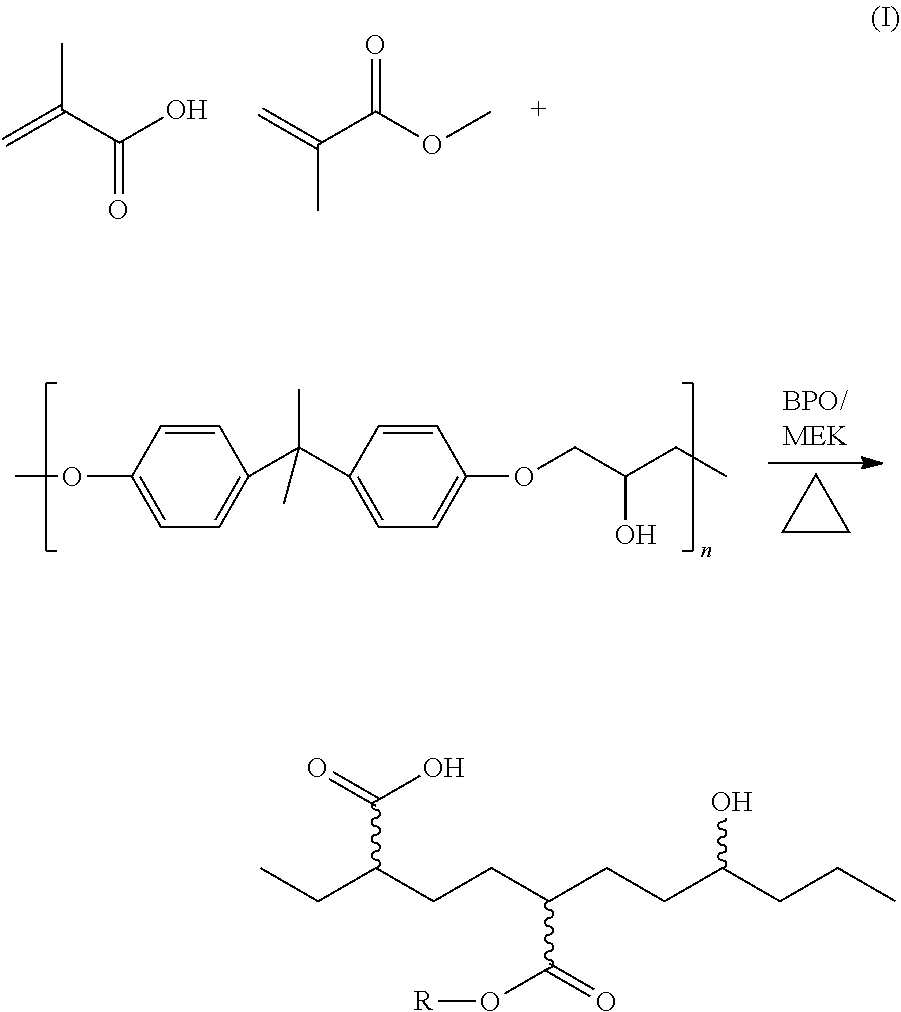Adhesive compositions based on grafted resins
a technology of adhesive composition and resin, applied in the direction of synthetic resin layered products, metal/metal-oxide/metal-hydroxide catalysts, chemical/physical processes, etc., can solve the problems of not supporting bacterial growth, odorless, tasteless, etc., to achieve robust bonding, easy to apply, and increase molecular weight and potential crosslink density
- Summary
- Abstract
- Description
- Claims
- Application Information
AI Technical Summary
Benefits of technology
Problems solved by technology
Method used
Image
Examples
example 1
rature LSR and the Role of Propylene Carbonate
[0092]
Constituent: 5555-1A: LOW TEMPERATURE FORMULA-A SIDE: Weight (10:1, A / B) PercentPhenoxy Resin (MMA / MAA grafted) 17.24 Propylene Carbonate 28.19 MEK 54.57 Total A 100
[0093]
Constituent: 5555-2A: LOW TEMPERATURE FORMULA-A SIDE: No propylene carbonate Weight (10:1, A / B) PercentPhenoxy Resin (MMA / MAA grafted) 17.24 MEK 82.76 Total A 100
[0094]
Constituent: 5555-1B: LOW Weight TEMPERATURE B-SIDE: (10:1 A / B) PercentPlatinum Catalyst 6.0 Xylene 94.0
[0095]
Constituent: 5555-2B: LOW Weight TEMPERATURE B-SIDE: (10:1 A / B) PercentPlatinum Catalyst 6.0 Xylene 94.0
[0096]The adhesives were spray applied to the rigid substrate (polycarbonate / SS), at a dry film thickness of about 10 microns, dried at 65° C. for 15 minutes and then placed in a mold and the LSR was injected and the assemblies cured for 5 minutes at 65° C. For LSR, this is considered to be a “low temp” cure.
[0097]The table below shows the grafted polymers ability to pick-up low temperatur...
example 2
erature LSR Resin Comparison
[0099]
Adhesive 2-1 Constituent: 5489-5: NEW POLYMER FORMULA Weight (10:1, A / B) PercentMDI-Uretdione 2.0 Phenoxy Resin (MMA / MAA grafted) 12.7 Propylene Carbonate 5.0 MEK 9.5 Cyclohexanone 70.8 Total A 100
[0100]
Weight Constituent: LORD E1009230B PercentPlatinum Catalyst 7.2 Xylene 92.8
[0101]
Comparative 2-1 Constituent: LORD E1009395A: Weight (10:1, A / B) PercentMDI-Uretdione 2.0 Phenoxy Resin (ungrafted) 12.7 Propylene Carbonate 5.0 MEK 9.5 Cyclohexanone 70.8 Total A 100
[0102]
Comparative 2-25584-5 AQWeight4:1 A / BPercent MDI-Uretdione13.15Phenoxy Resin (modified water dispersed)11.72Dapro W-770.175Water75.0Total A100
[0103]
E1009129BWeightB-side to AQPercentPlatinum Catalyst0.2Propylene carbonate98.8
[0104]The adhesives were spray applied to the rigid substrate (either stainless steel or polycarbonate), at a dry film thickness of about 10 microns, dried at 65° C. for 15 minutes and then placed in a mold and the LSR was injected and the assemblies cured for 5 mi...
example 3
ntal 85° C. / 85% RH Testing with the Grafted Polymer Formula
[0108]This is a 14 day environmental test at 85° C. / 85% RH using the best performing iteration 5489-5* using multiple LSR formulations on polycarbonate and stainless steel. These tests show the superior performance of the adhesive containing methacrylic acid grafted phenoxy resin.
[0109]
Rubber Retention after 14 days at 85 / 85 Polycarbonate 121 Stainless Steel 316LSR 1 100 100 LSR 2 100 100 LSR 3 5 100 LSR 4 100 100
PUM
| Property | Measurement | Unit |
|---|---|---|
| weight percent | aaaaa | aaaaa |
| weight percent | aaaaa | aaaaa |
| weight percent | aaaaa | aaaaa |
Abstract
Description
Claims
Application Information
 Login to View More
Login to View More - R&D
- Intellectual Property
- Life Sciences
- Materials
- Tech Scout
- Unparalleled Data Quality
- Higher Quality Content
- 60% Fewer Hallucinations
Browse by: Latest US Patents, China's latest patents, Technical Efficacy Thesaurus, Application Domain, Technology Topic, Popular Technical Reports.
© 2025 PatSnap. All rights reserved.Legal|Privacy policy|Modern Slavery Act Transparency Statement|Sitemap|About US| Contact US: help@patsnap.com



